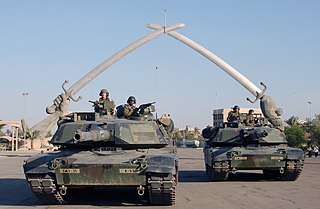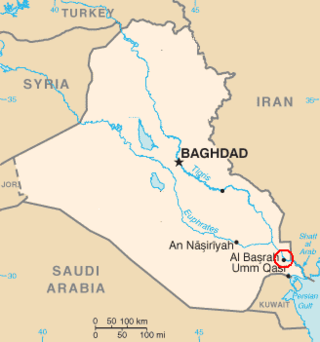
This is a timeline of the events surrounding the United States-led invasion of Iraq in 2003.

The following is a timeline of major events during the Iraq War, following the 2003 invasion of Iraq.

The Mahdi Army was an Iraqi Shia militia created by Muqtada al-Sadr in June 2003 and disbanded in 2008.

After the 2003 invasion of Iraq was completed and the regime of Saddam Hussein was toppled in May 2003, an Iraqi insurgency began that would last until the United States left in 2011. The 2003–2006 phase of the Iraqi insurgency lasted until early 2006, when it escalated from an insurgency to a Sunni-Shia civil war, which became the most violent phase of the Iraq War.
Events in the year 2005 in Iraq.

Tal Afar is a city in the Nineveh Governorate of northwestern Iraq, located 63 km (39 mi) west of Mosul, 52 km (32 mi) east of Sinjar and 200 km (120 mi) northwest of Kirkuk. Its local inhabitants are exclusively Turkmen.

The 2004 Iraq spring fighting was a series of operational offensives and various major engagements during the Iraq War. It was a turning point in the war; the Spring Fighting marked the entrance into the conflict of militias and religiously based militant Iraqi groups, such as the Shi'a Mahdi Army.
The Battle of Najaf took place on 28 January 2007 at Zarqa near Najaf, Iraq, between Iraqi Security Forces and fighters, initially thought to be Sunni insurgents but later reported to be members of the Shia Islam cult Soldiers of Heaven, who had joined a gathering of worshippers – or, by other accounts, a conflict, originally between an Iraqi government forces checkpoint and 200 armed pilgrims, which then expanded to include local residents, the Soldiers of Heaven group, and UK and U.S. forces. Reportedly, over 250 cult members and 11-25 members of the Iraqi security forces, and two U.S. soldiers were killed.

The Diyala province campaign was a series of operations conducted by coalition forces against Iraqi insurgents and a number of bombing and guerrilla attacks against the security forces in Diyala Governorate of Iraq, with the purpose of control of the province.
The 2008 Nineveh campaign was a series of offensives and counter-attacks between insurgent and Coalition forces for control of the Nineveh Governorate in northern Iraq in early-to-mid-2008. Some fighting also occurred in the neighboring Kirkuk Governorate.

The Battle of Basra began on 25 March 2008, when the Iraqi Army launched an operation to drive the Mahdi Army militia out of the southern Iraqi city of Basra. The operation was the first major operation to be planned and carried out by the Iraqi Army since the invasion of 2003.

The 2008 Iraq spring fighting was a series of clashes between the Mahdi Army and allies and the Iraqi Army supported by coalition forces, in southern Iraq and parts of Baghdad, that began with an Iraqi offensive in Basra.

The siege of Sadr City was a blockade of the Shi'a district of northeastern Baghdad carried out by US and Iraqi government forces in an attempt to destroy the main power base of the insurgent Mahdi Army in Baghdad. The siege began on 4 April 2004 – later dubbed "Black Sunday" – with an uprising against the Coalition Provisional Authority following the government banning of a newspaper published by Muqtada Al-Sadr's Sadrist Movement. The most intense periods of fighting in Sadr City occurred during the first uprising in April 2004, the second in August the same year, during the sectarian conflict that gripped Baghdad in late 2006, during the Iraq War troop surge of 2007, and during the spring fighting of 2008.
The 2013 Hawija clashes relate to a series of violent attacks within Iraq, as part of the 2012–2013 Iraqi protests and Iraqi insurgency post-U.S. withdrawal. On 23 April, an army raid against a protest encampment in the city of Hawija, west of Kirkuk, led to dozens of civilian deaths and the involvement of several insurgent groups in organized action against the government, leading to fears of a return to a wide-scale Sunni–Shia conflict within the country. By 27 April, more than 300 people were reported killed and scores more injured in one of the worst outbreaks of violence since the U.S. withdrawal in December 2011.
From 15 to 21 May 2013, a series of deadly bombings and shootings struck the central and northern parts of Iraq, with a few incidents occurring in towns in the south and far west as well. The attacks killed at least 449 people and left 732 others injured in one of the deadliest outbreaks of violence in years.
During the first two weeks of July 2013, a series of coordinated bombings and shootings struck across several cities in Iraq, killing at least 389 people and injuring more than 800 others.

Beginning in December 2012, Sunnis in Iraq protested against the Maliki government. On 28 December 2013, a Sunni MP named Ahmed al-Alwani was arrested in a raid on his home in Ramadi. Alwani was a prominent supporter of the anti-government protests. This incident led to violence in Al Anbar Governorate between the Iraqi Army and a loose alliance of tribal militias and other groups fighting alongside the Islamic State of Iraq and the Levant (ISIL).

The siege of Taiz is an ongoing, protracted military confrontation between opposing Yemeni forces in the city of Taiz for control of the city and surrounding area. The battle began one month after the start of the Yemeni Civil War.










